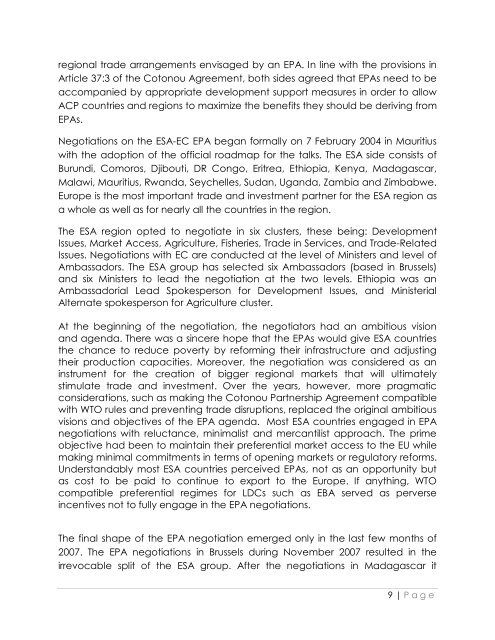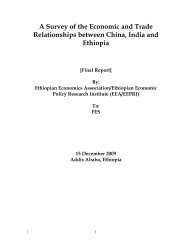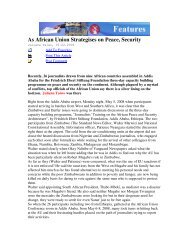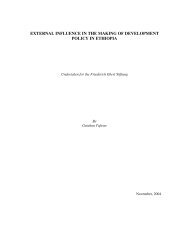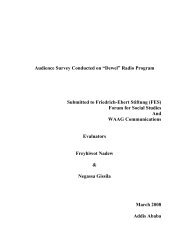Ethiopia and EPA Negotiation 2008 - FES Ethiopia
Ethiopia and EPA Negotiation 2008 - FES Ethiopia
Ethiopia and EPA Negotiation 2008 - FES Ethiopia
Create successful ePaper yourself
Turn your PDF publications into a flip-book with our unique Google optimized e-Paper software.
egional trade arrangements envisaged by an <strong>EPA</strong>. In line with the provisions in<br />
Article 37:3 of the Cotonou Agreement, both sides agreed that <strong>EPA</strong>s need to be<br />
accompanied by appropriate development support measures in order to allow<br />
ACP countries <strong>and</strong> regions to maximize the benefits they should be deriving from<br />
<strong>EPA</strong>s.<br />
<strong>Negotiation</strong>s on the ESA-EC <strong>EPA</strong> began formally on 7 February 2004 in Mauritius<br />
with the adoption of the official roadmap for the talks. The ESA side consists of<br />
Burundi, Comoros, Djibouti, DR Congo, Eritrea, <strong>Ethiopia</strong>, Kenya, Madagascar,<br />
Malawi, Mauritius, Rw<strong>and</strong>a, Seychelles, Sudan, Ug<strong>and</strong>a, Zambia <strong>and</strong> Zimbabwe.<br />
Europe is the most important trade <strong>and</strong> investment partner for the ESA region as<br />
a whole as well as for nearly all the countries in the region.<br />
The ESA region opted to negotiate in six clusters, these being: Development<br />
Issues, Market Access, Agriculture, Fisheries, Trade in Services, <strong>and</strong> Trade-Related<br />
Issues. <strong>Negotiation</strong>s with EC are conducted at the level of Ministers <strong>and</strong> level of<br />
Ambassadors. The ESA group has selected six Ambassadors (based in Brussels)<br />
<strong>and</strong> six Ministers to lead the negotiation at the two levels. <strong>Ethiopia</strong> was an<br />
Ambassadorial Lead Spokesperson for Development Issues, <strong>and</strong> Ministerial<br />
Alternate spokesperson for Agriculture cluster.<br />
At the beginning of the negotiation, the negotiators had an ambitious vision<br />
<strong>and</strong> agenda. There was a sincere hope that the <strong>EPA</strong>s would give ESA countries<br />
the chance to reduce poverty by reforming their infrastructure <strong>and</strong> adjusting<br />
their production capacities. Moreover, the negotiation was considered as an<br />
instrument for the creation of bigger regional markets that will ultimately<br />
stimulate trade <strong>and</strong> investment. Over the years, however, more pragmatic<br />
considerations, such as making the Cotonou Partnership Agreement compatible<br />
with WTO rules <strong>and</strong> preventing trade disruptions, replaced the original ambitious<br />
visions <strong>and</strong> objectives of the <strong>EPA</strong> agenda. Most ESA countries engaged in <strong>EPA</strong><br />
negotiations with reluctance, minimalist <strong>and</strong> mercantilist approach. The prime<br />
objective had been to maintain their preferential market access to the EU while<br />
making minimal commitments in terms of opening markets or regulatory reforms.<br />
Underst<strong>and</strong>ably most ESA countries perceived <strong>EPA</strong>s, not as an opportunity but<br />
as cost to be paid to continue to export to the Europe. If anything, WTO<br />
compatible preferential regimes for LDCs such as EBA served as perverse<br />
incentives not to fully engage in the <strong>EPA</strong> negotiations.<br />
The final shape of the <strong>EPA</strong> negotiation emerged only in the last few months of<br />
2007. The <strong>EPA</strong> negotiations in Brussels during November 2007 resulted in the<br />
irrevocable split of the ESA group. After the negotiations in Madagascar it<br />
9 | P a g e


